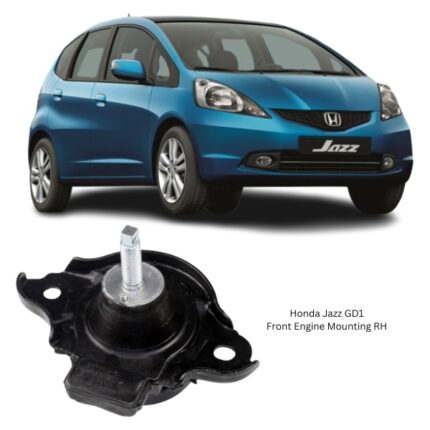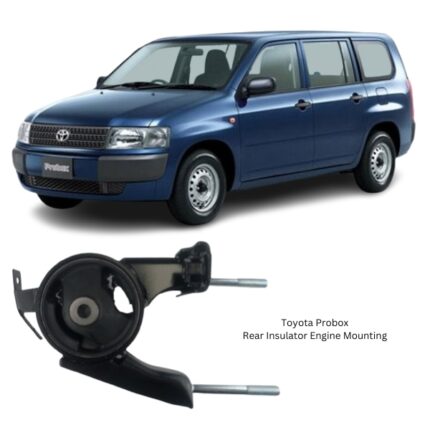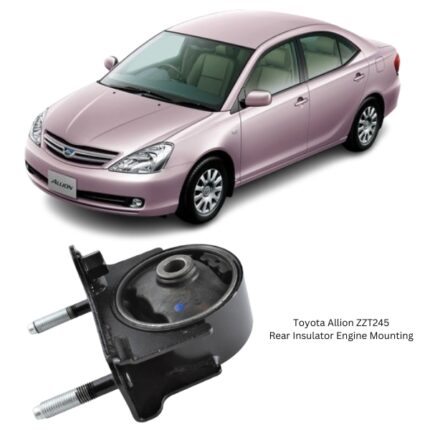-12%
Get Toyota Allion ZZT245 Rear Insulator Engine Mounting 12371-21120 in Kenya
The Rear Insulator Engine Mounting is a vital part of a vehicle’s engine mounting system, located at the rear section of the engine or transmission assembly. While often less visible than front or side mounts, its role is no less important. It supports the engine and transmission assembly, absorbs vibrations, and maintains alignment between critical drivetrain components. A properly functioning rear engine mount ensures a smoother, quieter, and more durable vehicle performance over time.
Engine mounts, including the rear insulator type, serve as the intermediary between the powertrain and the vehicle chassis. These mounts isolate engine movement caused by torque reactions, road impacts, and idling. Positioned at the rear of the engine or transmission housing, the rear insulator mount absorbs both vertical and longitudinal forces, ensuring drivetrain integrity while minimizing vibration and harshness.
Functionality and Purpose
The rear insulator engine mount fulfills several essential functions:
-
Engine and Transmission Support
It carries part of the combined weight of the engine and transmission, especially at the rear, ensuring the entire powertrain remains securely in place. -
Vibration Dampening
By absorbing engine-generated vibrations, it prevents noise and vibration from being transmitted into the cabin or the chassis. -
Control of Torque Reaction
It resists the rotational force that occurs during acceleration, gear shifts, and deceleration, keeping the engine from excessive rocking or movement. -
Driveline Alignment
It helps maintain accurate positioning of the engine and transmission relative to the driveshaft, axles, and exhaust system. -
System Protection
A stable rear engine mount protects surrounding systems—such as the exhaust, cooling hoses, and wiring—from undue stress and premature wear.
Without a reliable rear insulator mount, excessive drivetrain movement can result in decreased comfort, mechanical misalignment, and even failure of connected parts.
Design and Construction
The Rear Insulator Engine Mounting is engineered using a combination of durable and flexible materials. Its construction is carefully balanced to provide rigidity for support and elasticity for vibration absorption.
Common Components Include:
-
Outer Housing or Bracket
Typically made from forged steel, cast iron, or high-strength stamped metal, this forms the structural body that bolts to the chassis or subframe. -
Rubber or Polyurethane Insulator
The core vibration-dampening material is bonded between the metal housings. It may be natural rubber or a synthetic elastomer, chosen for its flexibility, heat resistance, and longevity. -
Center Sleeve or Bushing
A metal sleeve is molded into the rubber insulator to accept a bolt, securing the mount to the engine or transmission casing while allowing limited and controlled movement. -
Hydraulic Chamber (in advanced types)
Some mounts contain a sealed hydraulic fluid chamber designed to provide advanced damping of low-frequency vibrations and engine idle oscillations. -
Anti-Corrosion Coating
Metal surfaces are often treated with zinc plating, powder coating, or anodizing to resist corrosion from engine fluids, heat, and environmental exposure. -
Heat Shield (optional)
Where installed near exhaust components, a heat shield may be integrated to protect the rubber from thermal degradation.
These elements work together to deliver optimal performance under both static and dynamic loading conditions.
Performance Features
The performance of a rear insulator engine mount depends on its ability to consistently isolate and support under stress. Its key attributes include:
-
Load-Bearing Strength
Engineered to support rear-side loads from the engine and transmission, as well as road-induced shocks and cornering forces. -
Superior Vibration Isolation
Effectively dampens vibrations in all directions—vertical, lateral, and longitudinal—improving comfort and reducing noise. -
Fatigue Resistance
Built to endure thousands of compression, extension, and torsional cycles without failure or significant loss of elasticity. -
Thermal Stability
Performs reliably under extreme under-hood temperatures, often above 100°C. -
Chemical Resistance
Withstands contact with engine oil, transmission fluid, coolant, and road contaminants. -
Durability Across Driving Conditions
Functions optimally whether the vehicle is idling, accelerating hard, carrying heavy loads, or operating in rough terrain.
When working in tandem with front and side engine mounts, the rear mount ensures the overall engine stability and alignment required for safe and efficient operation.
Symptoms of a Failing Rear Engine Mount
Like all engine mounts, the rear insulator type wears out over time due to aging rubber, mechanical stress, and environmental exposure. Common signs of failure include:
-
Excessive Vibration or Cabin Noise
As the rubber degrades, it fails to dampen vibrations effectively, resulting in increased cabin vibrations—especially at idle. -
Clunking or Banging Sounds
A failing mount may allow the engine or transmission to move excessively, producing impact noises during gear changes or over bumps. -
Engine Movement or Rocking
Visual movement of the engine when revving in neutral or shifting from park to drive/reverse indicates poor support. -
Cracked or Split Rubber
A visual inspection may reveal damaged rubber or delamination from the metal housing. -
Fluid Leakage (in hydraulic mounts)
Hydraulic mounts may leak fluid if the internal chamber ruptures, leading to a drop in damping performance. -
Drivetrain Misalignment
A worn mount may allow sagging that affects the geometry of axles, driveshafts, or exhaust pipes, potentially causing drivability issues.
Timely diagnosis and replacement prevent damage to critical engine components and improve vehicle comfort and safety.
Follow us on Facebook for more parts.





Reviews
Clear filtersThere are no reviews yet.